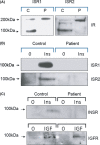Two novel mutations identified in familial cases with Donohue syndrome
- PMID: 24498630
- PMCID: PMC3907912
- DOI: 10.1002/mgg3.43
Two novel mutations identified in familial cases with Donohue syndrome
Abstract
Donohue syndrome (DS) is a rare and lethal autosomal recessive disease caused by mutations in the insulin receptor (INSR) gene, manifesting marked insulin resistance, severe growth retardation, hypertrichosis, and characteristic dysmorphic features. We report the clinical, molecular, and biochemical characterization of three new patients with DS, and address genotype-phenotype issues playing a role in the pathophysiology of DS. A female infant born to first-degree cousins Muslim Arab parents and two brothers born to first-degree cousins Druze parents presented classical features of DS with hypertrophic cardiomyopathy and died in infancy. Each patient was found homozygous for one missense mutation within the extracellular domain of the INSR gene. Western blot analysis identified the proreceptor of INSR, but not its mature subunits alpha and beta. Of 95 healthy Muslims, no heterozygous was found and of 52 healthy Druze from the same village, one was heterozygous. This study presents two novel familial mutations in the alpha subunit of the INSR which appear to impair post-translational processing of the INSR, resulting loss of its function. Both mutations cause DS with hypertrophic cardiomyopathy and early death. Identification of the causative mutation enables prevention of this devastating disease.
Keywords: Cardiomyopathy; Donohue syndrome; genotype–phenotype; insulin receptor..
Figures



References
-
- Ahmad S, Mahmoudi H, Naeem M, Betz RC. Autosomal recessive isolated familial acanthosis nigricans in a Pakistani family due to a homozygous mutation in the insulin receptor gene. Br. J. Dermatol. 2013;169:476–478. - PubMed
-
- Alatzoglou KS, Hindmarsh PC, Brain C, Torpiano J, Dattani MT. Acanthosis nigricans and insulin sensitivity in patients with achondroplasia and hypochodroplasia due to FGFR3 mutations. J. Clin. Endocrinol. Metab. 2009;94:3959–3963. - PubMed
-
- Baykan A, Cansever M, Konuskan B, Nihal H, Kazim U, Nazmi N. Hypertrophic cardiomyopathy with leprechaunism. J. Pediatr. Endocrinol. Metab. 2008;21:317–318. - PubMed
-
- Bonora E, Kiechl S, Willeit J, Oberhollenzer F, Egger G, Meigs JB, et al. Insulin resistance as estimated by homeostasis model assessment predicts incident symptomatic cardiovascular disease in caucasian subjects from the general population: the Bruneck study. Diabetes Care. 2007;30:318–324. - PubMed
-
- Carrera P, Cordera R, Ferrari M, et al. Substitution of Leu for Pro-193 in the insulin receptor in a patient with a genetic form of severe insulin resistance. Hum. Mol. Genet. 1993;2:1437–1441. - PubMed
LinkOut - more resources
Full Text Sources
Other Literature Sources
Medical
Molecular Biology Databases
Miscellaneous

